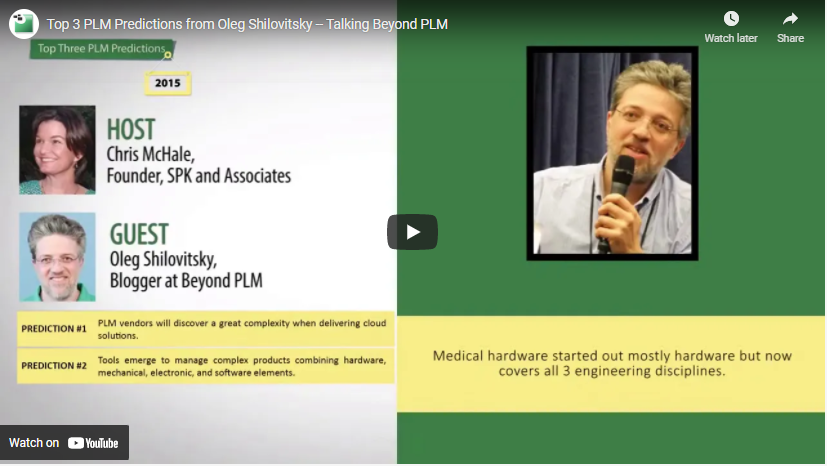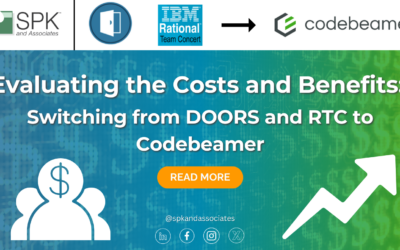SPK and Associates co-founder Chris McHale previously spoke with PLM expert Oleg Shilovitsky, founder of BeyondPLM.com, to get his top three product lifecycle management (PLM) predictions for 2015. Now they are teaming up monthly to discuss relevant industry items uncovered by Oleg’s blog. Below is their first episode of “Talking Beyond PLM” followed by a transcript.
Transcript:
Chris: Hi, this is Chris McHale, cofounder and COO of SPK and Associates, and I’m here with Oleg Shilovitsky who is a well-known blogger on topics of PLM—or product lifecycle management—over the last five years or so. Oleg and I will be producing a podcast once a month where we will dive a little deeper into one of his key topics from his recent blogging post. So, Oleg, would you take a moment to just introduce yourself and tell everybody a little bit about yourself?
Oleg: Sure. Hi, I am Oleg Shilovitsky. As Chris mentioned, I am writing a blog about PLM, Beyond PLM, the last six years, and today I am also going to talk in manufacturing and software companies about data management and different topics related to the engineering and manufacturing software.
Chris: That’s great. Thanks, Oleg. So today we’re going to investigate further the idea of cloud CAD, the PDM, which Oleg has written quite a bit about the last month or so, and the impact that cloud CAD will have on engineering in the product development lifecycle. And the evolution right now, cloud CAD and PDM is kind of fascinating to watch. And, Oleg, you know quite a bit about this and I wonder if you could start by giving our listeners a description more or less of what cloud CAD is considered to be and some recent developments in this area.
Oleg: Sure. Cloud came to us probably in the early 2010, and it’s really impacted the large amount of web and consumer applications that’s been utilizing cloud and sales technology. It became quite obvious that enterprise technology and engineering software can get some advantages of using cloud. And it was clearly not understood from the beginning what project a cloud technology can take with an engineering software.
One of the things that was quite obvious was that cloud can improve collaboration, and we have seen quite a few attempts to use cloud for collaboration, viewing and product lifecycle management. The topic of cloud CAD was a long period of time out of scope of the conversation. The conventional wisdom of people said CAD is a heavy application that requires a lot of local data to be edited, and there is a low chance that CAD will be common to the cloud any soon.
It is also a topic of security was in this part of concerns of many companies and many people. If we can put our design, eventually our company IP on the cloud, what we have seen is that for the last two years, some development happened in this space. One of the first cloud CAD applications that we have seen in the market was Autodesk’s Fusion 360, which introduced a capability to make a design and collaborate between people online using cloud technology.
Another company that is raising cloud in discussion, conversation, and attention is Onshape founded by ex-SolidWorks founder. It’s also raising a lot of questions and bringing a lot of attention. And this is probably another cloud CAD application that is very usable these days.
Chris: So, Oleg, what do you see as some of the pros and cons that are associated with cloud CAD or really some of the benefits and challenges that this will bring to engineering and product development?
Oleg: Obviously one of the challenges that cloud CAD systems are facing is how to handle data. And one of the most interesting things that happened with the cloud CAD development is that it changed the breakdown that we knew until now between systems like CAD PDM and PLM. So what we see is that in order to improve collaboration and allow two people to design together and get access to data, cloud CAD systems should come with a very solid foundation that with managing data revisions and allow two people to store data in a centralized way in a cloud.
So that’s probably one of the most interesting parts that’s related to data management and collaboration. And it’s changed the way people use CAD system between teams. It’s actually something that’s quite required by people that work globally today in different places.
Another aspect of development is actually how to use and how to design things using different technologies such as browser technologies or different devices, mobile devices and other devices. From that aspect, we can see companies are taking different directions and some of them like Fusion360 is installing application on the computers and using applications on mobile devices. And some other companies like Onshape are using full in-browser technologies to allow design and data manipulation to the cloud.
Chris: It strikes me, Oleg, with what you’re saying there about the benefits. I wonder if, in a way, one of the benefits is that it’s going to really enable more creativity on the part of the engineers. First of all, the fact that you can do this on any device is one. But also it takes the idea of the data management away from everything, and it’s just putting it back into what are we creating and how are we trying to create this together. That’s what strikes me based on what you’re saying. Is that what it seems to you as well or…?
Oleg: Yes, there are a couple of things here. First is simplicity and actually simplicity is hard to get CAD installed or used for the browser. So how to improve, you can start using the application and how simple is the application and how easy you can collaborate. And on the last point, EDM was a big challenge before for people to store files and send them via email or any other options. And today the cloud CAD actually helps people to collaborate and do it in a much easier way.
Chris: We have to give up our idea of files really which we’ve started to do already with Google Drive and items like that that teaches cloud software I guess like that and let go of that. The engineers would have to do the same thing to let go of the idea, “This is a CAD file or my CAD files,” or, “I have to keep them on my device,” or, “I have to keep complete control over them,” and kind of relinquish that control and just give themselves over to the creative part of this.
Oleg: Yeah, what happens with files is actually very interesting. The connection of files and CAD, I have to give some credit to Dassault and their Catia v6. If you remember back in 2006 or 2007, the French produced Catia v6, which was using only a backend and database to store data. If you think about that from a cloud perspective, you can actually think of this as the beginning of cloud CAD, because essentially what Dassault did is the CAD design application Catia, storing the data in the database and the data store in all the PLM.
Think about cloud today and cloud CAD today. Cloud CAD is using some data and technology application servers and infrastructure that allows them to save data, not files, in the cloud storage. From that point, it looks very similar. But, look, it took almost ten years from the frist introduction of the technological concept and first application to the cloud CAD delivery. And of course a bundle of Catia v6 with Enovia was hard to install. And if you think about cloud CAD today, cloud first of all eliminates the need to have the infrastructure installation and making it very simple.
Chris: It strikes me as you’re talking that… Well, first let me ask a question. Since it’s taken ten years, to some degree, for the adoption of the Catia v6 and the associated PLM from Enovia, here we are with the advent of things like Onshape or Fusion 360 from the Autodesk, how long do you think it will take for at least some adoption to happen? And I’m wondering where you see that adoption happening first. What size businesses or even what industries if you have any predictions or thoughts about that?
Oleg: I think this is the kind of question that everybody wants to have the answer, but at least I will know I’m sure we don’t have this answer today. I think this is something that will develop in front of our eyes and it’s still very dependent on many factors that we clearly cannot predict. But a very important element of the cloud CAD development is how cloud CAD vendors will be able to find a particular segment of customers, a particular niche of the market that will make easy cloud CAD introduction. That will be the beginning and other companies [inaudible 00:11:46].
It’s obviously clear that the first companies will not be leading this… and that’s why it’s interesting to see how industries our development of cloud CAD adoption will happen in the next few years.
Chris: It strikes me that one of the probably prime areas or sectors, I guess, that would want to adopt something like this is first and foremost smaller companies, because they are more concerned about the creativity, more concerned about getting something together quickly, collaboration, and less concerned about control. Whereas larger enterprise seems as if it would be the last to adopt to the table. That’s just how it seems. But then with these smaller companies, if they do start to adopt this, they’re the ones that get purchased by those larger companies and then you have an issue of perhaps it forcing itself upstream that way. It’s just a thought or a series. I was wondering what you thought about that.
Oleg: I found very interesting that always when we introduce new products or new technologies, we are saying for large companies, it will take longer, and for small companies, it will take less time and they will explore the new opportunities with new technology. And the cloud CAD is one of them. It is a valid point. For small companies, it’s easier. They have lesser restrictions. Their decision process is easier.
At the same time, we need to remember that small companies are very conservative in terms of return on the investment. Think about an engineering shop which has about two, three installations of SolidWork. What will drive their adoption of cloud CAD, they will need to replace all their practices, the way they design, the way they use the application. It’s many things together. So they are very conservative. They will need to see a clear return on the investment, and the way how you transform.
To think about yourself, you’re using some tools. You’re using some office tools, email applications, and everything. Think about replacing it for a moment for something else. Take a moment to think why. That’s more or less what I expect from engineers in small companies, in small engineering shops to think why they should adopt cloud CAD tomorrow and then have good reasons to do so such as collaboration, ease of use, ease of management, etc. But I’m sure they’ll find some others that they will have to consider before they will be making a shift.
Chris: Cost could factor in there quite considerably, couldn’t it? And maybe it’s not the existing smaller business, but any startup that says… I don’t have to buy three seats of SolidWorks, for example. I could do this on a subscription basis, and as long as the actual use of the tools doesn’t require a big change, because that I could see as a showstopper. They wouldn’t want to change with the designing and if it requires a retraining or something different from an engineering perspective.
Oleg: Price certainly will be a decision factor, and some cloud CAD companies and products are suggesting very interesting and innovative ways for price and for business models essentially. This is something that Onshape people call “price for privacy”. You pay for privacy. Essentially too, as you know, it’s free. But you can only have five products [inaudible 00:16:02] that you can keep in privacy. If you want to have more, then essentially you should pay for this privacy.
But it can turn back an interesting conversation about how much data and how much project small companies will need and how much they’re interested to share what they do online in public. There’s a lot of interesting developments that I can see will happen in the near future, and we will learn more how existing companies and new companies or startups are adopting this cloud CAD technology. There are lots of interesting things that we will see in the next couple of years.
Chris: Finally, Oleg, could you call it one of the challenges? I think with the cloud CAD idea is the offline access, and I know you’ve looked into that a little bit. Do you want to comment on what you’re finding there and how much of a challenge that’s going to be to the adoption of cloud CAD?
Oleg: Yes, so far, it’s one of the topics that’s raising discussions especially between two vendors – Onshape and Autodesk. The reason is very simple, because Autodesk is saying offline is important and Onshape, for the moment, is saying offline is not important. If you want to use cloud CAD, you assume to have good internet connection. I think it’s kind of local for the moment, the conversation that happened now. I think for the future we can see it may change, and just as an example like in bringing the Google applications, if you remember from the beginning, it was only online. And then Google tried to bring offline with a technology called Google Gears. It was a complete failure. It didn’t work. And Google pulled off of this conversation, but now they’re coming back and you can use Google Applications offline.
So I think it will take time to figure out and I will not be surprised if we will see Onshape in the future supporting offline, maybe. Who knows? And some other differentiator that we see today will disappear in the future. It usually happens in the beginning when the technology is new and companies are trying to outline their differentiators.
Chris: Yes, perhaps it’s a second iteration, but we’ll have to get through the cloud CAD conversations first and then maybe the offline gets addressed later or perhaps it becomes also important. Who knows? Well, thanks, Oleg, very much for your time today. Really appreciate you sharing your thoughts and your knowledge about this area, which is a very interesting topic for people in the engineering space these days, and we look forward to speaking with you again next month. So thanks very much.
Oleg: Thank you, Chris, for inviting me. I look forward for the future conversations. Thank you.
Chris: Okay. Thanks.
Next Steps:
- Contact SPK and Associates to see how we can help your organization with our ALM, PLM, and Engineering Tools Support services.
- Read our White Papers & Case Studies for examples of how SPK leverages technology to advance engineering and business for our clients.






